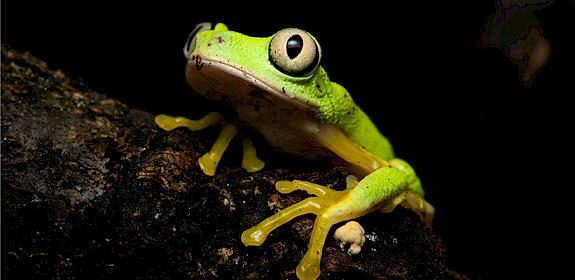
Caged in the City An inventory of birds for sale in Ha Noi and Ho Chi Minh City
Silver-eared Mesias for sale in Ha Noi © James Eaton / TRAFFIC
i
- »
- Publications »
- Reports »
- Caged in the City
Published 21 September 2017
An inventory of birds for sale in Hanoi and Ho Chi Minh City
Viet Nam, 21st September 2017—A new study warns that Viet Nam’s sizeable trade in wild birds is going unchecked and could harm wild populations if not managed.
Caged in the City
Report author(s):
James A. Eaton, Minh D. T. Nguyen, Madelon Willemsem, Jessica Lee, Serene C. L. Chng
Publication date:
September 2017
key findings
During a three-day survey, TRAFFIC researchers found 8,047 birds of 115 species offered for sale by 52 vendors in the country’s largest cities: Ha Noi and Ho Chi Minh City.
Of the thousands of birds observed in April 2016 over 99% were of species native to Viet Nam, while regulations governing the trade exist for only some 771 (10%) of the total: indeed, nine of the top 10 most abundant species recorded during the survey were not subject to any trade controls under Vietnamese legislation.
The survey findings are consistent with a thriving demand for native birds within Viet Nam. However, as trade in most of the species seen is not regulated by law, it means large numbers of birds are being extracted with no oversight of sustainability or how severely it will impact wild populations.
Kanitha Krishnasamy, Acting Regional Director for TRAFFIC in Southeast Asia.
She said the survey showed a rise in the number of species and volume of birds for sale since previous studies in 1991, 1998, 2001 and 2008; adding that the volumes, the array of species and high number of immature individuals for sale were all a sign of the need for improved monitoring of the trade including regulation of offtake and oversight of any ranching or captive breeding operations.
Scaly-breasted Munias Lonchura punctulata (21%) and Red-whiskered Bulbuls Pycnonotus jocosus (15%) were most abundant in the survey, collectively reaching close to 3,000 individuals. Both are legally tradeable. The latter species, popular in the cage-bird trade, was also one of the most abundant species previously recorded by TRAFFIC in Singapore and Bangkok bird markets.
Meanwhile seven species recorded in the two cities in Viet Nam match those recognized in the Conservation Strategy for Southeast Asian Songbirds in Trade as being directly threatened by trade in the region. The seven are White-rumped Shama Copsychus malabaricus, Oriental White-eyes Zosterops palbebrosus, Oriental Magpie-robin Copsychus saularis, Silver-eared Mesia Leiothrix argentauris, Common Hill Myna Gracula religiosa, Java Sparrow Lonchura oryzivora and Asian Fairy Bluebird Irena puella.
The report recommends improved monitoring and regulation of the harvest and trade of wild caught bird species to ensure it does not negatively affect wild populations.
The authors specifically call for Viet Nam’s current legislation to include range-restricted endemic birds and species assessed as globally threatened in the IUCN Red List within protected species lists.
“TRAFFIC stands ready to support Vietnamese authorities in any effort to review and strengthen current regulations. We will continue to provide information on the levels of bird trade in Viet Nam—this critical knowledge will help to identify the need and urgency to adjust policies and regulations so that Viet Nam meets its international commitments on conserving biodiversity,” said Madelon Willemsen, Head of TRAFFIC’s Viet Nam Office.
“These findings present us with better knowledge of the scale of bird trade in the region and emphasizes the species, especially native sub-species, common in the regional bird trade. This is crucial information for any regional bird conservation effort,” said Dr Sonja Luz, Director of Conservation, Research and Veterinary, Wildlife Reserves Singapore, which funded the survey.
The Caged In The City: An inventory of birds for sale in Ha Noi and Ho Chi Minh City, Viet Nam report marks TRAFFIC’s sixth inventory of notable bird markets in the region—the others were in Indonesia (3), Thailand and Singapore, collectively recording 60,000 birds in trade.
The release of this report coincides with the launch of Silent Forest, the European Association of Zoos and Aquaria's new campaign to address and mitigate the songbird extinction crisis in Asia and increase awareness within and beyond the zoo community.
8,047 birds
were observed for sale across Hanoi and Ho Chi Minh City
115 species
were offered for sale by vendors
90% of species
were not subject to any trade controls within Viet Nam




